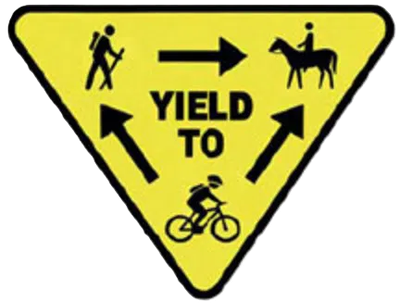Trail Etiquette
How to have a safe, enjoyable experience on the trails

We live on an increasingly crowded planet, and trails, whether we hike or ride them, are a refuge from the daily grind. And while these wonderful strips of bare ground in our open spaces help us escape from civilization, it often seems like the rest of civilization is escaping on them at the same time, creating the possibility of less-than-civilized encounters.
This is where etiquette comes in. Etiquette isn’t just about holding out your pinky when you take afternoon tea; it has practical application on the trail. Even if you develop all the skill and fitness in the world, without proper etiquette, you can be a detriment to the sport.
Before we hit the high points of trail etiquette, let’s look at a few reasons why etiquette is important:
1. The most obvious reason is simply safety for all users, being a good neighbor to other trail users.
2. Even if you’re not concerned about your fellow trail user, most rules of bike trail etiquette protect the rider as well. For instance, if you fail to yield to a horse, guess who wins? 1,400lbs of spooked animal can be a bit dangerous.
3. Even if you’re not concerned with your safety, trail etiquette is necessary to preserve access to trails and maintain the possibility of gaining access to new trails.
Just like so much in life, a split-second decision for a quick moment of fun can have negative long term consequences–not just for yourself, but for all your fellow users. Not riding when it would damage the trail, or not ruining a hiker or equestrian’s outing, is a courtesy to your fellow bikers (and yourself) as well as other trail users.
Here are six easy steps to good multi-user trail relations:
1. Ride Open Trails: Respect trail and road closures — ask a land manager for clarification if you are uncertain about the status of a trail. Do not trespass on private land. Obtain permits or other authorization as required. Be aware that bicycles are not permitted in areas protected as state or federal Wilderness.
2. Leave No Trace: Be sensitive to the dirt beneath you. Wet and muddy trails are more vulnerable to damage than dry ones. When the trail is soft, consider other riding options. This also means staying on existing trails and not creating new ones. Don’t cut switchbacks. Be sure to pack out at least as much as you pack in.
3. Control Your Bicycle: Inattention for even a moment could put yourself and others at risk. Obey all bicycle speed regulations and recommendations, and ride within your limits.
4. Yield Appropriately: Do your utmost to let your fellow trail users know you’re coming — a friendly greeting or bell ring are good methods. Try to anticipate other trail users as you ride around corners. Bicyclists should yield to other non-motorized trail users, unless the trail is clearly signed for bike-only travel. Bicyclists traveling downhill should yield to ones headed uphill, unless the trail is clearly signed for one-way or downhill-only traffic. In general, strive to make each pass a safe and courteous one.
5. Never Scare Animals: Animals are easily startled by an unannounced approach, a sudden movement, or a loud noise. Give animals enough room and time to adjust to you. When passing horses, use special care and follow directions from the horseback riders (ask if uncertain).
6. Plan Ahead: Know your equipment, your ability, and the area in which you are riding, and prepare accordingly. Strive to be self-sufficient: keep your equipment in good repair and carry necessary supplies for changes in weather or other conditions. Always wear a helmet and appropriate safety gear.